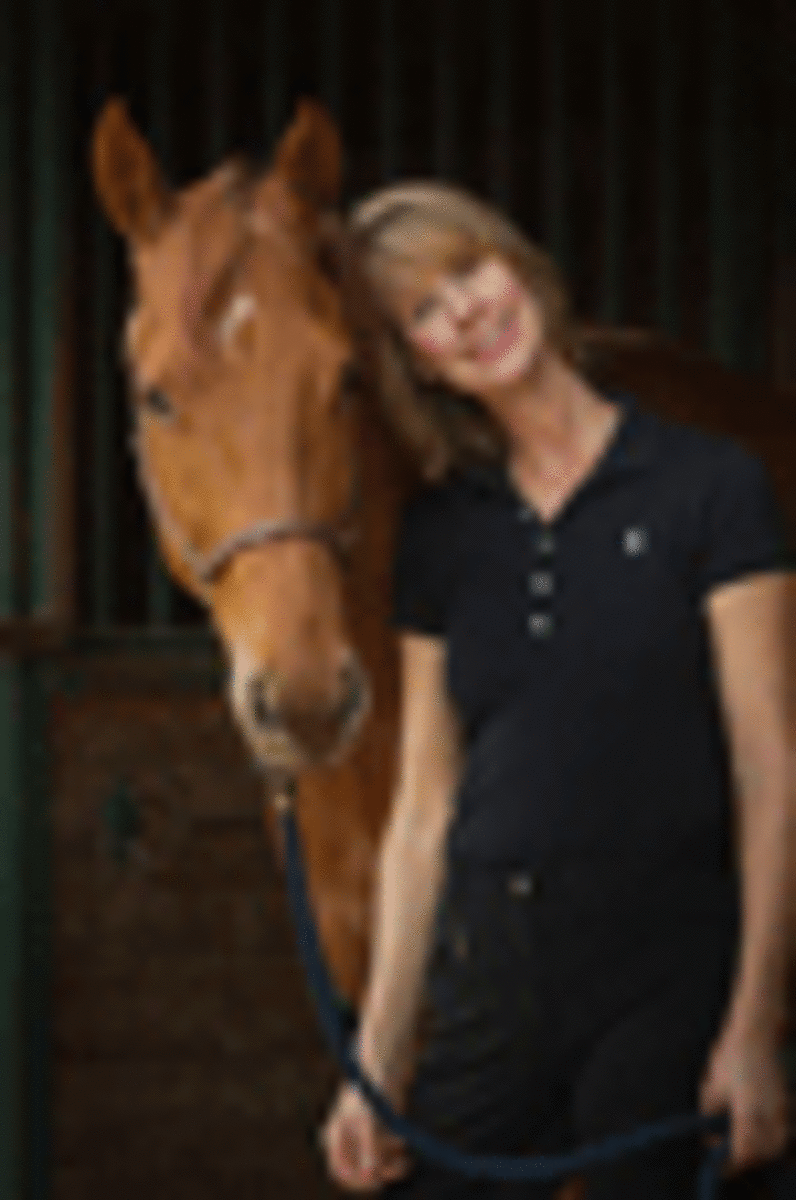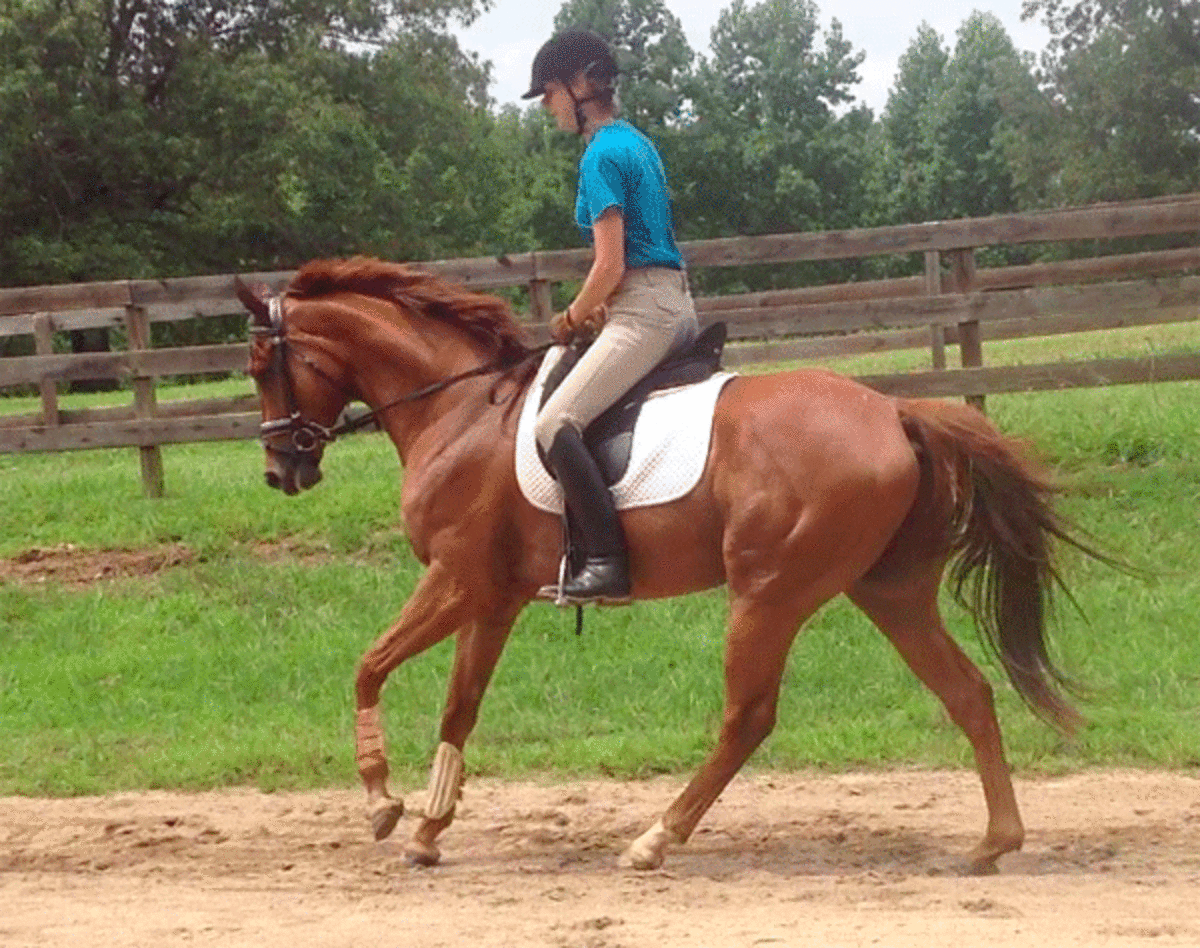Now that I’ve felt Forrest is a bit more confirmed in trot, in both directions, the brief pause between rain showers seemed a good day to introduce my boy to canter. So long as the warm-up trot work remained consistent and obedient, on this, our 9th ride undersaddle, together.

There’s a wonderful riding proverb that says, “Ride the horse you have today.” This means that while we all can have ambitious plans as we tack up (i.e., “Today, we’re going to do a flying change!” or “Time to tackle that canter pirouette”) all of that, frankly, has to get thrown out the window if you climb aboard and find the quality of your canter just isn’t there or you’re struggling to get your horse off the right rein.
From his racing days, Forrest is used to moving by overloading his left shoulder. And, as I ride him, I’m tempted to call up the sitcom actress, Suzanne Sommers, and say, “Hey, you know that ‘thigh master’ you were flogging on the tube? Let me tell you, that is nothing compared to what you have to do to keep an OTTB’s left shoulder in line!”
So before I actually attempt our first canter, I want to make sure that the straightness we have worked on in the trot has been retained by Forrest and that I am keeping my seat centered and my overall position as exemplary as possible. It’s important that I honestly feel I ‘have his back’… is he loose? Can I, even in these baby stages, ask him to stretch, pick him back up to his Training Level outline, and stretch again? So far, so good.

Giving a ton of vocal praise (honestly, if you heard me ride you’d think I was a bit loopy), I prepare for our first canter depart. I make the same mistake I did, the first time I asked for a trot, too tentative an aid. What Ireceive is what I deserve: runny steps, a confused and slightly irritated horse. Apologizing profusely, I swear at myself, re-organize, come around to the next short side and as we approach, I sit, close my outside hand, slide my outside leg slightly back, scoot my inside seat bone forward and give him the vocal cue he knows well: “and can-TER!” Like clockwork, Forrest gives me a lovely, obedient, depart, remaining easily connected and rather proud of himself.

I figured as my horse has only had a jockey stand in the stirrups during this gait, he might not be too comfortable with me sitting deeply in the saddle, so I adopted a sort of ‘half-seat;’ not two-point, just sorta forward to allow his back to come up and remain relaxed. I was rewarded with quite an impressive reach from behind.

After a constant chorus of “Good BOY!!” we cantered around the arena, threw in a big circle, and then landed easily into trot and what struck me was the last two strides of canter, before the downward transition, were surprisingly collected- what a gift of ‘sit’ he seems to have. Showing the video to Jane Savoie, I received some super helpful comments, particularly in being careful not to let the trot get too over tempo, but to train Forrest to take longer, slower steps on a circle. Great advice as I’ll admit, I have been riding him a little quicker than I should, only because he’s slightly phlegmatic to the leg. But continuing to do that, as opposed to Jane’s good advice, will only result in a horse going about bouncing off stiff legs and back … a horse’s joints need time to flex, fold, take the weight and then push off the ground. And if you want them to stay sound, you’d better make sure you’re giving them that needed time. It’s just another example of why ‘rhythm’ is the bottom rung of the Training Scale.

I’m particularly pleased with Forrest’s willingness to follow my hand in the subsequent stretch at the trot as a reward for the canter. I remember reading a quote from a respected dressage master that a horse would rather have a stretch than a pat, after hard work, as a reward. And besides, that stretch is an indicator of correct work … your horse is asking to stretch the correct muscles he’s been using.
So a brilliant day! I don’t mind telling you how relieved I was to get this first canter under our collective belts. But I can hear all you OTTB owners smiling wryly and saying, “Yeah, but can you canter him to the right?!” I’ll let you know in next week’s blog!











